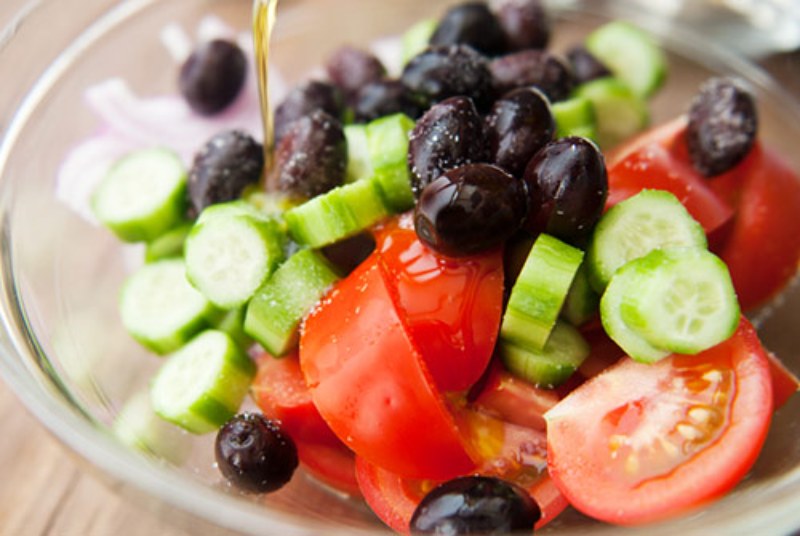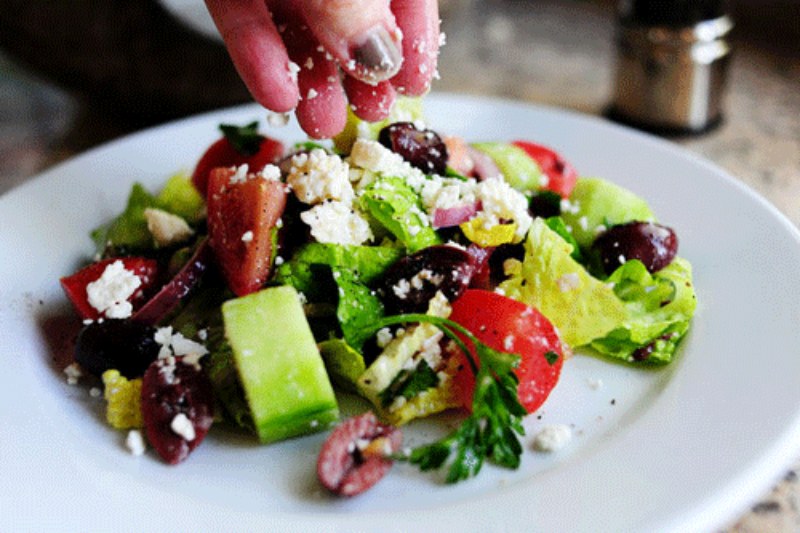Get free consultation
Fill out the form and we will contact you
Greek salad, or Horiatiki, is an iconic dish of Mediterranean cuisine, celebrated for its freshness, simplicity, and health benefits. From juicy tomatoes to creamy feta cheese, this salad is not only a culinary experience but also reflects the healthy lifestyle of the Greek people. Let’s explore the origins, preparation, and interesting facts about Greek salad!
Greek salad, called Horiatiki (meaning “village salad” in Greek), is a traditional dish representing the Mediterranean diet. The salad combines fresh ingredients such as tomatoes, cucumbers, red onions, bell peppers, Kalamata olives, and feta cheese, all drizzled with extra virgin olive oil and sprinkled with oregano. The uniqueness of Greek salad lies in its simplicity – it uses no lettuce or complicated dressings, preserving the natural freshness and flavor of the vegetables.
Greek salad, also known as Horiatiki
Recognized by UNESCO as an intangible cultural heritage, the Mediterranean diet, with Greek salad as an essential component, is praised for its health benefits, helping to reduce the risk of cardiovascular disease and promote longevity. This dish is popular not only in Greece but also worldwide, appearing in fine dining restaurants as well as family meals.
Greek salad originated in the rural regions of Greece, where people used ingredients readily available from their gardens. In the 20th century, it became popular in Athens and tourist areas, especially as Greek tourism developed during the 1960s and 1970s. The name “Horiatiki” reflects its rustic and approachable nature, embodying the Greek philosophy of living in harmony with nature.
In Greek culture, Greek salad is often served as an appetizer or a side dish during family meals, festivals, or gatherings. The dish is not just food but also a symbol of philoxenia (hospitality), as Greeks traditionally share their meals with guests. At seaside tavernas, Greek salad is typically served on the table alongside pita bread and ouzo, creating an unforgettable culinary experience.
Greek salad is often served as an appetizer
4 ripe tomatoes, cut into wedges
1 cucumber, thinly sliced
1 red onion, thinly sliced
1 green bell pepper, sliced
100g feta cheese, cut into blocks or left whole
50g Kalamata olives
3 tablespoons extra virgin olive oil
1 teaspoon dried oregano
Salt and black pepper to taste
(Optional) Red wine vinegar or lemon juice for extra tang
Prepare the ingredients: Wash the tomatoes, cucumber, and bell pepper. Cut the vegetables into bite-sized pieces, not too small to maintain crunchiness.
Mix the salad: Place tomatoes, cucumber, red onion, bell pepper, and olives in a large bowl. Sprinkle with salt and pepper to taste.
Add cheese and seasoning: Place the feta cheese on top (you can leave it in blocks for presentation). Drizzle with olive oil, sprinkle oregano, and add a little vinegar or lemon juice if desired.
Serve: Avoid mixing too vigorously to prevent breaking the feta. Serve the salad with pita bread or enjoy immediately to retain freshness.
Tips: Use fresh ingredients, especially extra virgin olive oil and authentic Greek feta, for the best flavor. Avoid adding lettuce or mayonnaise, as these are not part of the traditional style.
Greek salad is not only delicious but also offers numerous health benefits thanks to its natural ingredients:
Greek-style salad offers numerous health benefits
Rich in antioxidants: Tomatoes and bell peppers contain lycopene and vitamin C, which help boost immunity and protect the skin.
Heart-healthy: Olive oil and Kalamata olives provide unsaturated fats that help reduce bad cholesterol.
Supports digestion: Cucumbers and red onions are high in fiber, promoting a healthy digestive system.
Nutritionally balanced: Feta cheese provides protein and calcium, while the vegetables add vitamins and minerals.
According to research from Harvard University, the Mediterranean diet, with Greek salad as a staple, can reduce the risk of heart disease by 25% and help maintain a healthy weight. This is why the dish is favored by those following a healthy lifestyle.
Beyond the traditional recipe, Greek salad can be adapted to suit different tastes. Some suggestions include gợi ý:
Add protein: Pair with grilled chicken, shrimp, or salmon to make it a main course.
Vegan version: Replace feta cheese with tofu or vegan cheese.
Add grains: Include quinoa or couscous to increase satiety.
Greek salad is typically enjoyed in the summer, when vegetables are at their freshest. In Greece, it is often served during outdoor meals, under the shade of olive trees or by the Aegean Sea. For an authentic experience, try the salad at tavernas in Santorini or Crete, where ingredients are harvested fresh daily.
Thanks to the popularity of Greek cuisine, Greek salad has become a familiar dish in many countries. In the United States, the salad is often served with Romaine lettuce, while in Europe, the traditional recipe is usually preserved. Restaurant chains such as Zoes Kitchen and Cava have added Greek salad to their menus, helping to spread the flavors of the Mediterranean.
In Vietnam, Greek salad can also be found in European-style restaurants or healthy eateries. However, for an authentic experience, it is recommended to purchase feta cheese and Kalamata olives from imported supermarkets or make it at home following the traditional recipe above.
Enjoy Greek salad and explore life in Greece through the Golden Visa program! Contact quoctichthuhai.com for professional consultation on residency!
Fill out the form and we will contact you



